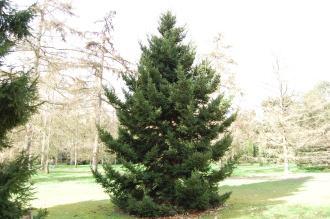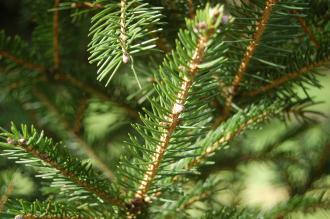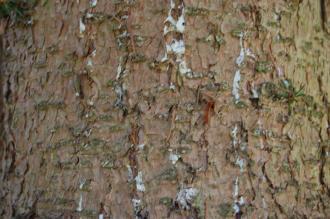
Picea maximowiczii (01/03/2015, Kew Gardens, London)
Position: Full sun to partial shade
Flowering period: Late spring
Soil: Moist, well drained
Eventual Height: 30m
Eventual Spread: 12m
Hardiness: 6b, 7a, 7b, 8a, 8b, 9a
Family: Pinaceae
Picea maximowiczii is an evergreen coniferous tree with a conical crown. Its mid green leathery leaves are needle like, up to 20mm long and 1mm across. Its trunk may achieve a diameter of up to 1m. Its grey/ brown bark is fissured and peel off in thin scales. Its male flowers are pollen cones. Its fruit are oblong pendulous cones, up to 7cm long and 2cm across, maturing to brown.

Picea maximowiczii Leaf (01/03/2015, Kew Gardens, London)
Picea maximowiczii, commonly known as Japanese Bush Spruce, is native to Japan. In its native habitat it grows in mountainous regions of Honshu (main island. Picea maximowiczii is classified as ‘Endangered’ according to the IUCN List of Threatened Species.
The etymological root of the binomial name Picea is derived from the Lain Pix meaning ‘pitch’ or ‘tar’ in reference to the Spruce tree’s resin. Maximowiczii is named after Karl Johann Maximovicz (1827 – 1891), a Russian botanist.

Picea maximowiczii Bark (01/03/2015, Kew Gardens, London)
Picea maximowiczii is rarely available in cultivation, although it would make an attractive coniferous tree.
Ecologically, Picea maximowiczii cones are attractive to some birds and mammals.
Picea maximowiczii prefers moist, fertile, well-drained soils. It prefers an acid to neutral pH of soil.
Picea maximowiczii requires little maintenance.

